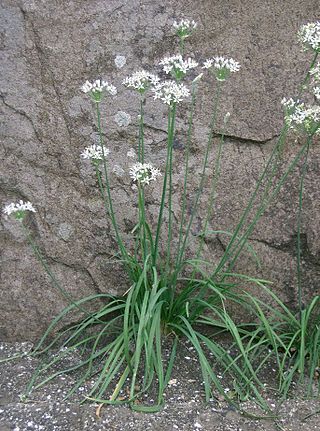
Garlic is a species of bulbous flowering plant in the genus Allium. Its close relatives include the onion, shallot, leek, chive, Welsh onion, and Chinese onion. It is native to South Asia, Central Asia and northeastern Iran and has long been used as a seasoning worldwide, with a history of several thousand years of human consumption and use. It was known to ancient Egyptians and has been used as both a food flavoring and a traditional medicine. China produced 73% of the world's supply of garlic in 2021.

In botany, a bulb is structurally a short stem with fleshy leaves or leaf bases that function as food storage organs during dormancy.

Penicillium is a genus of ascomycetous fungi that is part of the mycobiome of many species and is of major importance in the natural environment, in food spoilage, and in food and drug production.

Allicin is an organosulfur compound obtained from garlic. When fresh garlic is chopped or crushed, the enzyme alliinase converts alliin into allicin, which is responsible for the aroma of fresh garlic. Allicin is unstable and quickly changes into a series of other sulfur-containing compounds such as diallyl disulfide. Allicin is an antifeedant, i.e. the defense mechanism against attacks by pests on the garlic plant.

Allium tuberosum is a species of plant native to the Chinese province of Shanxi, and cultivated and naturalized elsewhere in Asia and around the world.

Allium vineale is a perennial, bulb-forming species of wild onion, native to Europe, northwestern Africa and the Middle East. The species was introduced in Australia and North America, where it has become a noxious weed.

Solo garlic, also known as single clove garlic, chinese garlic, monobulb garlic, single bulb garlic, or pearl garlic, is a type of Allium sativum (garlic). The size of the single clove differs from approximately 25 to 50 mm in diameter. It has the flavour of the garlic clove but is somewhat milder and slightly perfumed. The appearance is akin to that of a pickling onion, with white skin and often purple stripes. Compared to traditional garlic, Solo garlic offers the advantage of being easy to peel quickly.

Stemphylium solani is a plant pathogen fungus in the phylum Ascomycota. It is the causal pathogen for grey leaf spot in tomatoes and leaf blight in alliums and cotton, though a wide range of additional species can serve as hosts. Symptoms include white spots on leaves and stems that progress to sunken red or purple lesions and finally leaf necrosis. S. solani reproduces and spreads through the formation of conidia on conidiophores. The teleomorph name of Stemphyllium is Pleospora though there are no naturally known occurrences of sexual reproduction. Resistant varieties of tomato and cotton are common, though the pathogen remains an important disease in Chinese garlic cultivation.

In enzymology, an alliin lyase is an enzyme that catalyzes the chemical reaction

Snow Mountain garlic, is a subspecies of garlic which is found in the mountainous in Jammu and Kashmir. It grows well in the western Himalayas at altitudes of up to 1,800 m (6,000 ft), in temperatures as low as −10 °C (14 °F), and with very little oxygen. In Hindi, it is known as ek pothi lahsun.

Allium tuncelianum is a species of wild onion which is endemic to the Munzur Valley in Tunceli, in eastern Turkey.It usually produces a single-bulb white onion, unlike garlic, which has multiple bulbs. It has a garlic odor and taste and is used locally like garlic. Its common names include Tunceli garlic and Ovacik garlic. Botanists have suggested this species may be a close relative of garlic, and perhaps an ancestor of garlic, but genetic analysis shows that it is actually more closely related to leek. The plant is collected from the wild for use in cooking, a phenomenon that threatens the plant with extinction. It is known that Tunceli garlic shows higher antiradical activity and contains more total phenolic compounds than normal garlic. In addition, it is possible to say that Tunceli garlic is a better natural antioxidant than Kastamonu garlic. Tunceli garlic is single-toothed, has small tooth-like formations between its shells, has the familiar taste and aroma of garlic, unlike others, it can flower and give seeds. It has a chance to be used in consumption as well as in industry, due to its features such as being single-toothed, the number of shells being less compared to the cultivated garlic, and the storage of the head parts. It is stored for a long time at 18-20"C. It is collected from the mountains in the region and sold under the name of 'Rock garlic' and used as commercial goods. In an experiment conducted at Malatya Turgut Özal University, the effect of intraperitoneal injection of 1% and 10% doses of Tunceli garlic oil on some immunological factors of rainbow trout was evaluated. Rohu pups were fed a garlic supplemented diet for 60 days. This fish was then exposed to Aeromonas hydrophila by IP injection. Rainbow trout fry were fed garlic to groups for 14 days prior to intraperitoneal injection challenge with Aeromonas hydrophila per fish. In both of these studies, it was noted that fish fed garlic showed increased serum lysozyme and bactericidal activities and higher serum total protein.
Garlic is a species in the onion genus commonly used as a food flavoring.
Stromatinia cepivora is a fungus in the division Ascomycota. It is the teleomorph of Sclerotium cepivorum, the cause of white rot in onions, garlic, and leeks. The infective sclerotia remain viable in the soil for many years and are stimulated to germinate by the presence of a susceptible crop.

Botrytis allii is a plant pathogen, a fungus that causes neck rot in stored onions and related crops. Its teleomorph is unknown, but other species of Botrytis are anamorphs of Botryotinia species. The species was first described scientifically by Mancel Thornton Munn in 1917.
Penicillium allii-sativi is a fungus species of the genus Penicillium, section Chrysogena. It is one of several Penicillium species that can produce penicillin in culture. The fungus has been found in Argentina, Bulgaria, France, Portugal, South Africa, and the United Kingdom. The specific epithet allii-sativi refers to the garlic plant, Allium sativum, from which the fungus was isolated.
A species of the genus of Penicillium which causes Blue Mold of Garlic on Allium sativum L. The genus name is derived from the Latin root penicillum, meaning "painter's brush", and refers to the chains of conidia this fungus produces that resemble a broom.
White garlic may refer to:
Neotoxoptera formosana or the Onion aphid, is an aphid in the superfamily Aphidoidea in the order Hemiptera. It was originally discovered in Taiwan in 1921, but has spread all around the world. The aphid is dark reddish brown in color. Host plants include Allium ascalonicum, Allium cepa, Allium chinense, Allium fistulosum, Allium porrum, Allium sativum, Allium schoenoprasum, and Allium tuberosum.

Allium is a genus of monocotyledonous flowering plants with hundreds of species, including the cultivated onion, garlic, scallion, shallot, leek, and chives. The generic name Allium is the Latin word for garlic, and the type species for the genus is Allium sativum which means "cultivated garlic".

Puccinia porri is a species of rust fungus that causes leek rust. It affects leek, garlic, onion, and chives, and usually appears as bright orange spots on infected plants.












